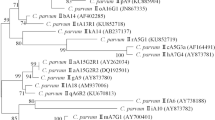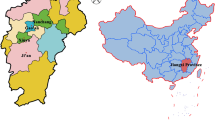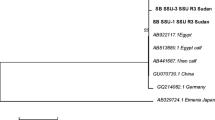Abstract
Cryptosporidiosis is a widespread cause of diarrheal diseases of humans, young calves, and many mammals. Although in recent years molecular investigations on Cryptosporidium have increased, no data are available on Iran in this regard. Two species of Cryptosporidium are known to infect human beings; Cryptosporidium hominis which shows anthroponotic transmission among humans and Cryptosporidium parvum which shows zoonotic transmission between animals and humans. Cryptosporidium oocysts, morphologically identified as C. parvum, were isolated from 24 human and 35 bovine cases in Shahriar (suburb of Tehran, Iran), and genotyped by means of a Nested-polymerase chain reaction/restriction fragment length polymorphism analysis of the 18s rRNA gene. The isolates from bovine samples gave zoonotic or 2 genotype (C. parvum), and DNA profiles of human isolates gave two distinct genotypes, namely an anthroponotic or 1 (C. hominis) and zoonotic genotype or 2 (C. parvum).


Similar content being viewed by others
References
Akiyoshi DE, Dilo J, Pearson C, Chapman S, Tumwine J, Tzipori S (2003) Characterization of Cryptosporidium meleagridis of human origin passaged through different host species. Infect Immun 71:1828–1832
Awad-El-Kariem FM, Robinson HA, Dyson DA, Evans D, Wright S, Fox MT, McDonald VM (1995) Differentiation between human and animal strains of Cryptosporidium parvum using isoenzyme typing. J Parasitol 110:129–132
Awad-El-Kariem FM, Robinson HA, Petry F, McDonald V, Evans D, Casemore D (1998) Differentiation between human and animal isolates of Cryptosporidium parvum using molecular and biological markers. Parasitol Res 84:297–301
Barwick RS, Levy DA, Craun GF, Beach MJ, Calderon RL (2000) Surveillance for waterborne disease outbreaks United States, 1997–1998. MMWR CDC Surveill Summ 49:1–21
Bonnin A, Fourmaux MN, Dubremetz JF, Nelson RG, Gobet P, Harly G, Buisson M, Puygauthier TD, Gabriel PF, Naciri M, Camerlynck P (1996) Genotyping human and bovine isolates of Cryptosporidium parvum by polymerase chain reaction-restriction fragment length polymorphism analysis of a repetitive DNA sequence. FEMS Microbiol Lett 137:207–211
Bornay-Llinares FJ, Da Silva AJ, Moura IN, Myjak P, Pietkiewitz H, Krumina-Lozowska W, Graczyk TK, Pieniazek NJ (1999) Identification of Cryptosporidium felis in a cow by morphologic and molecular methods. Appl Environ Microbiol 65:1455–1458
Bridgman SA, Robertson RM, Syed Q, Speed N, Andrews N, Hunter PR (1995) Outbreak of cryptosporidiosis associated with a disinfected groundwater supply. Epidemiol Infect 115:555–566
Carraway M, Tzipori S, Widmer G (1997) A new restriction fragment length polymorphism from Cryptosporidium parvum identifies genetically heterogeneous parasite populations and genotypic changes following transmission from bovine to human hosts. Infect Immun 65:3958–3960
Fayer R, Trout JM, Graczyk TK, Lewis EJ (2000) Prevalence of Cryptosporidium, Giardia and Eimeria infections in post-weaned and adult bovine on three Maryland farms. Vet Parasitol 93:103–112
Gasser RB, Youssef G, EL-Osta A, Prepens S, Chalmers RM (2004) An improved ‘cold SSCP’ method for the genotypic and subgenotypic characterization of Cryptosporidium. Mol Cell Probes 18:329–332
Gatei W, Greensill J, Ashford RW, Cuevas LE, Parry CM, Cunliffe NA, Beeching NJ, Hart CA (2003) Molecular analysis of the 18S rRNA gene of Cryptosporidium parasites from patients with or without human immunodeficiency virus infections living in Kenya, Malawi, Brazil, the United Kingdom, and Vietnam. Clin Microbiol 41:1458–1462
Guyot K, Follet-Dumoulin A, Lelievre E, Sarfati C, Rabodonirina M, Nevez G, Cailliez JC, Camus D, Dei-Cas E (2001) Molecular characterization of Cryptosporidium isolates obtained from humans in France. Clin Microbiol 39:3472–3480
Lee SH, Levy DA, Craun GF, Beach MJ, Calderon RL (2002) Surveillance for waterborne disease outbreaks United States, 1999–2000. MMWR CDC Surveill Summ 51:1–47
Limor JR, Lal AA, Xiao L (2002) Detection and differentiation of Cryptosporidium parasites that are pathogenic for humans by re0al-time PCR. Clin Microbiol 40:2335–2338
McLauchlin J, Amar C, Pedraza-Diaz S, Nichols GL (2000) Molecular epidemiological analysis of Cryptosporidium spp. in the United Kingdom: results of genotyping Cryptosporidium spp. in 1705 fecal samples from humans and 105 fecal samples from livestock animals. Clin Microbiol 38:3984–3990
Meamar AR, Guyot K, Dei-Cas E, Mohraz M, Mohebali M, Mohammad K, Mehbod AA, Rezaie S, Rezaian M (2007) Molecular characterization of Cryptosporidium isolates from humans and animals in Iran. Appl Environ Microbiol 73:1033–1035
Moore AC, Herwaldt BL, Craun GF, Calderon RL, Highsmith AK, Juranek DD (1993) Surveillance for waterborne disease outbreaks United States, 1991–1992. MMWR CDC Surveill Summ 42:1–22
Morgan UM, Pallant L, Dwyer BW, Forbes DA, Rich G, Thompson RC (1998a) Comparison of PCR and microscopy for detection of Cryptosporidium parvum in human fecal specimens: clinical trial. Clin Microbiol 36:995–998
Morgan UM, Sargent KD, Deplazes P, Forbes DA, Spano F, Hertzberg H, Elliot A, Thompson RC (1998b) Molecular characterization of Cryptosporidium from various hosts. J Parasitol 117:31–37
Morgan UM, Fall A, Ward LA, Hijjawi N, Sulaiman I, Fayer R, Thompson RC, Olson M, Lal A, Xiao L (2002) Cryptosporidium hominis n. sp. (Apicomplexa: Cryptosporidiidae) from Homo sapiens. J Eukaryot Microbiol 49:433–440
Park JH, Guk SM, Han ET, Shin EH, Kim JL, Chai JY (2006) Genotype analysis of Cryptosporidium spp. prevalent in a rural village in Hwasun-gun, Republic of Korea. Korean J Parasitol 44:27–33
Peng MM, Xiao L, Freeman AR, Arrowood MJ, Escalante AA, Weltman AC, Ong CSL, MacKenzie WR, Lal AA, Beard CB (1997) Genetic polymorphism among Cryptosporidium parvum isolates: evidence of two distinct human transmission cycles. Eme Inf Dis 3:567–573
Pieniazek NJ, Bornay-Llinares FJ, Slemenda SB, Da Silva AJ, Moura INS, Arrowood MJ, Dietrich O, Addiss DG (1999) New Cryptosporidium genotypes in HIV-infected persons. Eme Inf Dis 5:444–449
QIAampÒ (2001) DNA Stool Mini Kit Handbook for DNA purification from stool samples
Schindler R, EL-Osta YG, Stevens M, Sinclair MI, Gasser RB (2005) Capillary electrophoretic analysis of fragment length polymorphism in ribosomal markers of Cryptosporidium from humans. Mol Cell Probes 19:394–399
Spano F, Putignani L, McLauchlin J, Casemore DP, Crisanti A (1997) PCR-RFLP analysis of the Cryptosporidium oocyst wall protein (COWP) gene discriminates between C. wrairi and C. parvum, and between C. parvum isolates of human and animal origin. FEMS Microbiol Lett 150:209–217
Spano F, Putignani L, Crisanti A, Sallicandro P, Morgan UM, Leblancq SM, Tchack L, Tzipori S, Widmer G (1998) Multilocus analysis of Cryptosporidium parvum isolates from different hosts and geographical origins. Clin Microbiol 36:3255–3259
Sulaiman IM, Morgan UM, Thompson RC, Lal AA, Xiao L (2000) Phylogenetic relationships of Cryptosporidium parasites based on the 70-kilodalton heat shock protein (HSP70) gene. Appl Environ Microbiol 66:2385–2391
Upton SJ, Current WL (1985) The species of Cryptosporidium (Apicomplexa: Cryptosporidiidae) infecting mammals. J Parasitol 71:625–629
Willocks L, Crampin A, Milne L, Seng C, Susman M, Gair R, Moulsdale M, Shafi S, Wall R, Wiggins R, Lightfoot N (1998) A large outbreak of cryptosporidiosis associated with a public water supply from a deep chalk borehole. Outbreak investigation team. Commun Dis Public Health 1:239–243
Xiao L, Escalante L, Yang C, Sulaiman I, Escalante AA, Montali RJ, Fayer R, Lal AA (1999) Phylogenetic analysis of Cryptosporidium parasites based on the small-subunit rRNA gene locus. Appl Environ Microbiol 65:1578–1583
Xiao L, Bern C, Limor J, Sulaiman I, Roberts J, Checkley W, Cabrera L, Gilman RH, Lal AA (2001) Identification of 5 types of Cryptosporidium parasites in children in Lima, Peru. Inf Dis 183:492–497
Xiao L, Sulaiman IM, Ryan UM, Zhou L, Atwill ER, Tischler ML, Zhang X, Fayer R, Lal AA (2002) Host adaptation and host-parasite co-evolution in Cryptosporidium: implications for taxonomy and public health. Int Parasitol 32:1773–1785
Xiao L, Fayer R, Ryan U, Upton SJ (2004) Cryptosporidium taxonomy recent advances and implications for public health. Clin Microbiol rev 17:72–97
Zhhiliang WU, Nagano I, Boonmars T, Takahashi Y (2004) Further evidence that genotype I and genotype II of Cryptosporidium parvum are distinct. Trop Med and Health 32:5–14
Acknowledgements
This study was funded by Tarbiat Modares University. The authors wish to thank Dr. Ghafari, Dr. Sharifi, and the personnel of Imam Sadjad and Tamin Ejtemaei Hospitals and the Veterinary Organization of Tehran for their assistance.
Author information
Authors and Affiliations
Corresponding author
Rights and permissions
About this article
Cite this article
Pirestani, M., Sadraei, J., Dalimi asl, A. et al. Molecular characterization of Cryptosporidium isolates from human and bovine using 18s rRNA gene in Shahriar county of Tehran, Iran. Parasitol Res 103, 467–472 (2008). https://doi.org/10.1007/s00436-008-1008-2
Received:
Accepted:
Published:
Issue Date:
DOI: https://doi.org/10.1007/s00436-008-1008-2




